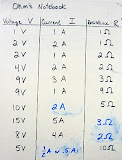Here is the review for the LAST TEST OF THE YEAR! Yaaaaaay!
The page numbers correspond to the brown version of the textbook.
p.535
7. How many joules per coulomb are given to charges that flow in a 120 volt circuit?
16. Why is it that a bird can perch without harm on a high voltage wire?
22. Where do the electrons that flow in a typical electric circuit come from?
24. Which of these is a unit of power and which is a unit of electrical potential energy: a watt, a kilowatt, or a kilowatt-hour?
2. Ten coulombs of charge pass a point in 5 seconds. What is the current at that point?
3. A battery does 18 joules of work on 3 coulombs of charge. What voltage does it supply?
5. What is the effect on current in a circuit if both the voltage and the resistance are doubled? If both are halved? Explain.
10. How many amperes flow in a 60-watt bulb rated for 120 volts when it is connected to a 120 volt circuit? How many amperes would flow if it were connected to 240 volts?
p.549
2. Why are household appliances almost never connected in series?
6&7. Cannot reproduce here; involves finding the equivalent resistance and total current in two circuits.
10. Why should you not use a copper penny in place of a safety fuse that blow out (or a circuit breaker that is tripped)?
Monday, May 17, 2010
Friday, May 14, 2010
Compound Circuits Practice
Bellwork begins:

Finding equivalent resistance step by step:



Finding the total current and solving the circuit...you really needed to be there...

The rest of the period was spent finishing Concept-Development 35-2 (see previous post) and starting HW: Electricity V.
Note: on the back of the honors version, the 6 ohm resistor needs to be changed to an 8 ohm resistor. You're still going to get a lot of fractions, but it is doable!

Finding equivalent resistance step by step:



Finding the total current and solving the circuit...you really needed to be there...

The rest of the period was spent finishing Concept-Development 35-2 (see previous post) and starting HW: Electricity V.
Note: on the back of the honors version, the 6 ohm resistor needs to be changed to an 8 ohm resistor. You're still going to get a lot of fractions, but it is doable!
Labels:
electricity,
homework,
ohm's law
Thursday, May 13, 2010
Compound Circuits
Part of bellwork:

Another example of finding equivalent resistance:



One more example:




Homework:
Concept-Development 35-2 front
Concept-Development 35-2 back

Another example of finding equivalent resistance:



One more example:




Homework:
Concept-Development 35-2 front
Concept-Development 35-2 back
Labels:
electricity,
homework,
ohm's law
Wednesday, May 12, 2010
Tuesday, May 11, 2010
Monday, May 10, 2010
Friday, May 7, 2010
Wednesday, May 5, 2010
Tuesday, May 4, 2010
Voltage/Ohm's Law Practice
Bellwork:

We also practiced Ohm's Law with HW: Electricity II and started the back of Concept-Development 34-2:

Don't start the front! we'll be doing that tomorrow.

We also practiced Ohm's Law with HW: Electricity II and started the back of Concept-Development 34-2:

Don't start the front! we'll be doing that tomorrow.
Labels:
electricity,
homework,
ohm's law
Subscribe to:
Comments (Atom)














